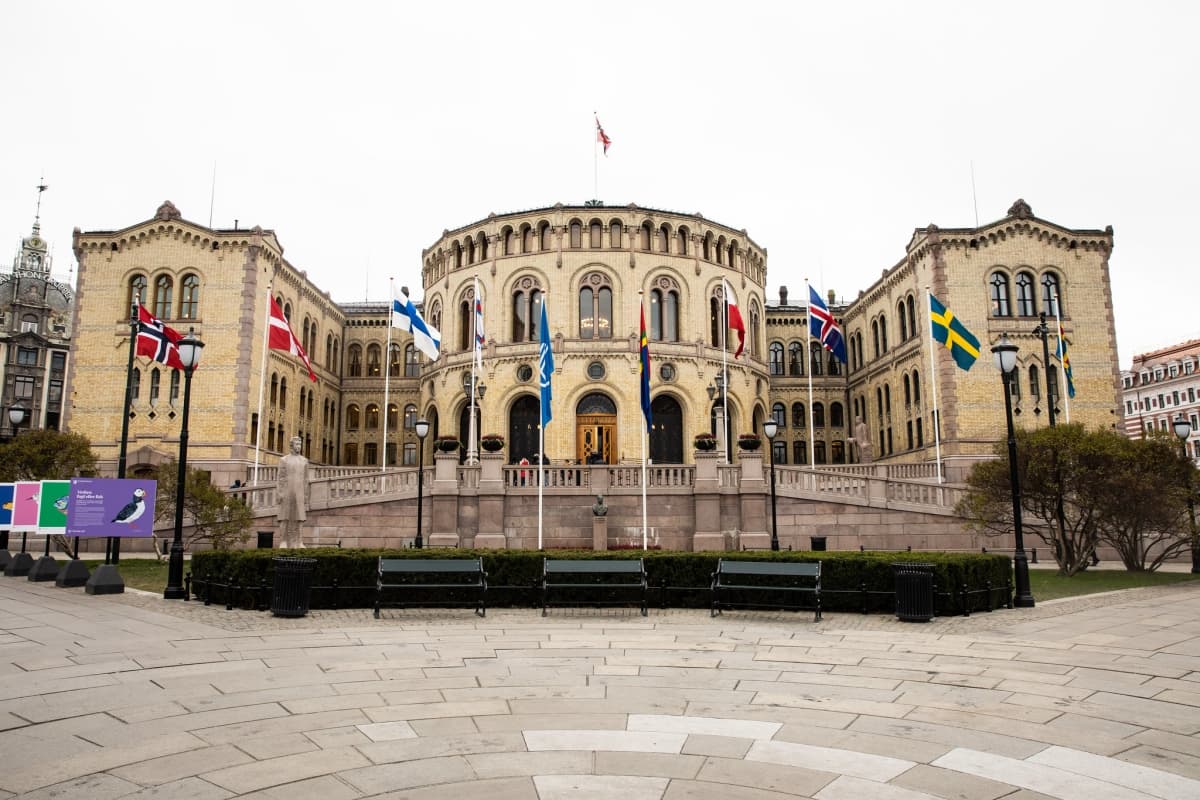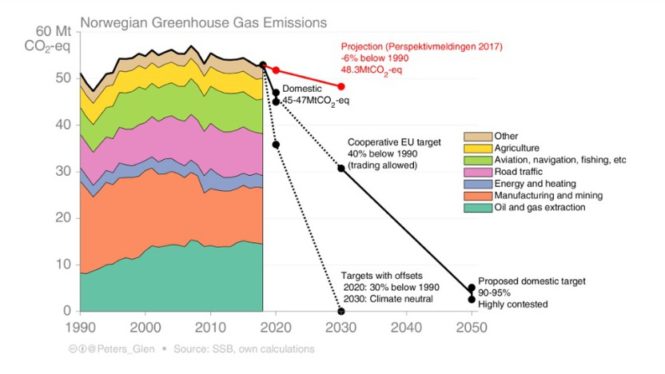Climate neutrality the Norwegian way: Carbon trading?
Norway’s target of climate neutrality by 2030 is not enshrined in law, impossible to reach without massive use of flexible mechanisms, and currently lacks a clear governmental strategy. A frontrunner in the net zero debate?

What do the decisions on carbon neutrality by the Norwegian parliament really mean? Photo of Stortinget during the Nordic Council meeting in October 2018.
Already in 2008, the Norwegian Parliament decided that Norway should become “climate neutral” by 2050, and that this goal could even be expedited to 2030 if an ambitious global climate agreement was in place. Eight years later, on June 14 2016, the same day Norway ratified the Paris Agreement, the Parliament followed through on this, stating that the condition for expediting the climate neutrality target to 2030 was met.
Because of this political process, Norway is often seen as a pioneer in the “net zero” debate, by adopting a deadline for reaching zero emissions earlier than most countries. In terms of policies and strategies to reach the target, however, the picture is quite different. Indeed, the government even tried to stop the parliamentary decision to expedite the target to 2030, warning against unknown costs and consequences.
This reluctance to embrace the target is still visible today. In contrast to the UK for instance, where the net zero target rests on a thorough assessment by the Climate Change Committee, there is currently no governmental assessment or strategy underlying the 2030 climate neutrality target. Instead, the Government intends to return to Parliament with a review of the follow-up of the climate neutrality decision at a “suitable” point in time.
It is unclear how the Norwegian target should be interpreted, and how it relates to other aspects of Norway’s climate policy. The only thing that seems clear is that it will require flexible mechanisms (carbon trading in different forms). On a massive scale.
Norway needs flexible mechanisms
To understand the confusion surrounding Norway’s climate neutrality target, it is important to note that it was adopted well before the idea of reaching “net zero” greenhouse gas emissions globally had become part of discussions about climate policy.
When adopted in 2008, the target was therefore not modelled on the goal of the Paris Agreement to achieve a “balance” between emissions and removals of greenhouse gases, or the scientific understanding that halting emissions is necessary to stabilize temperature.
Rather, the Norwegian target was seen as a version of the kind of climate neutrality you are sometimes offered when you purchase a flight or a new shirt: A vague promise that emissions are reduced as much as possible, and a clear commitment that remaining emissions are somehow offset – usually by buying some type of carbon credits.
In this sense, the climate neutrality target is part of a long tradition in Norwegian climate policy: Setting targets that depend on the use of so-called flexible mechanisms to be achieved. Today, Norwegian emissions are 3.4 per cent higher than in 1990. By 2020, they must be reduced by 30 per cent, which inevitably will require substantial use of flexible mechanisms.

Norway ‘climate member’ of the EU
Despite not being a member of the EU, Norway has since 2008 been part of the European Union – Emissions Trading System (EU ETS), and from 2019, Norway is part of the EUs Effort Sharing Regulation (ESR) and Land-Use Change and Forestry (LULUCF) regulation (at the least until 2030). For reaching its 2020 targets, Norway will have to rely on the EU ETS and the Clean Development Mechanism (CDM). Norway has a procurement process that screens CDM credits for quality.
By 2030, emissions shall have been slashed by 40 percent compared to 1990 in cooperation with the EU, which also will imply use of the EU flexibility mechanisms, such as the EU ETS. But the EU will not allow CDM after 2020. And Norway’s target of reaching climate neutrality by 2030 will practically be impossible without massive offsetting. What to do?
Offsets, which offsets?
OK, so the target depends on carbon trading. Surely, then, the government has a plan for what kind of flexible mechanisms it will use? Well, surprisingly, there is no concrete plan for how Norway can reach the climate neutrality target by 2030, even with carbon trading. The only way it is specified is that it can be met through measures in other countries, such as the EU ETS, “international cooperation on emission reductions, quota trading and project-based cooperation.” In other words, not very precise.
When the target was established in 2008, 2050 was far away, and the conditional promise to expedite the target to 2030 was tied to a new international climate agreement which was expected to establish new forms of carbon trading that would give Norway access to the offsets required. But when the Paris Agreement materialized, it did not provide a clear-cut solution to Norway’s offsetting needs: Article 6 of the Paris Agreement covers carbon trading but does not (yet) provide the strict and credible framework of UN-sanctioned credits that Norway has used under the Kyoto Protocol.
Government resistance
The lack of clear answers about future carbon trading, including costs, was the main reason why the government tried to dissuade Parliament from expediting the climate neutrality target when it ratified the Paris Agreement. The then sitting Minister of Climate and Environment, Vidar Helgesen, in fact took the unusual step of sending a letter warning parliamentarians not to push the target forward to 2030, because the government had no way of knowing the availability and costs of future carbon credits. Parliament nevertheless opted to expedite the target, arguing that Norway had to make good on its promise as the conditions set in 2008 were met with the ratification of the Paris Agreement.
Currently, Norway is the largest donor to an initiative exploring flexible mechanisms under the Paris Agreement article 6, the Transformative Carbon Asset Facility, and is also actively involved in the Carbon Partnership Facility program in the World Bank. Norway played a very active role in establishing and using the flexible mechanisms under the Kyoto protocol (most notably the Clean Development Mechanism) and will likely play an active role in putting the flexible mechanisms under the Paris Agreement into play.
Norwegian climate neutrality target is not law
Contrary to what many believe, Norway’s 2030 climate neutrality target is not enshrined in law, but a parliamentary decision, which is less binding than legislation. And it is a controversial parliamentary decision. As mentioned above, the climate minister warned against the decision to expedite the target, and the two major parties in the sitting right-wing coalition government opposed it in parliament – although they at one point voted in favor of it by what they claimed was a “working accident” or “inadvertence”. In other words, the climate neutrality target for 2030 has less support in Parliament than many other elements of Norwegian climate policy.
The legislation that does exist, the Norwegian Climate Act passed by Parliament on June 16 2017, makes no mention of the climate neutrality target. The act states that Norway shall be low-emission society by 2050, and that GHG emissions shall have been reduced by 80–95 per cent. In the current government declaration from January 17 2019, the Government raises this ambition to 90–95 per cent, i.e. strengthening the Climate Act targets by 10 per cent. However, neither in the Climate Act nor in the government declaration it is specified how much of these cuts will be taken domestically, and how much will be cut internationally through flexible mechanisms.
The sitting Minister of Climate and Environment, Ola Elvestuen, in June 2019 publicly stated that the 90–95 per cent cut was to happen at home. Immediately after, the Prime Minister watered down this ambition, and warned against being “bombastic” with regard to the proportion of cuts to be made domestically vs. abroad.
Nordic cooperation on carbon neutrality
Even if Norway’s climate neutrality target originally was conceived independent of the idea that emissions have to reach “net zero” globally, it has inevitably become caught up in discussions about this new form of “neutrality”, and is being compared to other countries’ net zero targets that are explicitly based on the goal of “balance” as mentioned in the Paris Agreement. This includes some high-level political initiatives in which Norway takes part.
In January 2019, the Nordic Prime Ministers issued a declaration where the countries commit to “working towards carbon neutrality in the five Nordic states and to pursuing Nordic climate diplomacy in international forums to deliver solutions with impact on the global emissions. We will catalyse global mitigation efforts to limit the increase in the global average temperature to 1.5°C in response to the findings of the Intergovernmental Panel on Climate Change Special Report on Global Warming of 1.5°C.”
However, the declaration does not explicitly exclude offsetting, and can even be interpreted as that the Nordics will cooperate to operationalize Article 6 in the Paris Agreement. Not least, it should be noted that this declaration utilizes the term carbon neutrality in contrast to climate neutrality, whereby the latter includes all GHGs and is therefore perceived as harder to achieve. Which may be used as an argument in favour of flexible mechanisms. However, it is expected that the Nordics soon will release a more detailed document on carbon neutrality cooperation.
EU is the leader, Norway is the follower
So far, Norway has “copied” EUs climate ambitions and targets (both in 2008 and 2015), and will most likely continue to do so, especially since Norway and the EU (most likely) will cooperate even more closely on climate policy in the years ahead, both in the EU ETS, the effort-sharing regulation, (ESR) and the LULUCF regulation. Currently there is a push in EU policy circles for setting a long term-term target for the EU to become climate-neutral or carbon neutral by 2050. If so, Norway is likely to follow, and at some point include this target in its revised Nationally Determined Contribution. But only as long Norway has access to flexible mechanisms.
What will Norway’s next emission reduction pledge look like?
At the climate summit in Katowice (COP24) in 2018, Parties failed to reach conclusions on the terms and conditions for the flexible mechanisms in the Paris Agreement. These mechanisms are on the agenda at the climate summit to be held in Chile (COP25) in December 2019, but there are no guarantees that the discussions will be concluded at the summit (it took seven years to negotiate the Kyoto mechanisms).
At the next climate summit in 2020 (COP 26), parties are to submit (or re-confirm) new Nationally Determined Contributions (emission pledges). In the Nordic declaration on carbon neutrality, it is stated that the signatories will submit enhanced Nationally Determined Contributions in 2020. It will therefore be very interesting to see and compare the wording of Norway’s and the EU’s new Nationally Determined Contributions with regard to net-zero, climate neutrality and carbon neutrality (if mentioned at all), given the uncertainty with regard to the design and implementation of flexible mechanisms, and the importance of these Nationally Determined Contributions for reaching the targets and ambitions set out in the Paris Agreement.
After all, 1.5 degrees is not that far away…